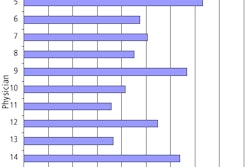The debate over who should be able to provide imaging services in America reached Capitol Hill today, with the American College of Radiology (ACR) at odds with other medical specialists and, to a lesser degree, the imaging vendor community.
Representatives from four groups were invited to testify this morning before the U.S. House of Representatives Ways and Means Subcommittee on Health, in a hearing on managing the use of imaging services.
Specifically, the committee invited speakers to address a recent recommendation by the independent Medicare Payment Advisory Commission (MedPAC), suggesting that the federal health program develop quality standards for all providers that receive payment for performing and interpreting imaging studies.
In a March 1 report to Congress, MedPAC argued that such standards "should improve the accuracy of diagnostic tests and reduce the need to repeat studies, thus enhancing quality of care and helping to control spending."
The MedPAC recommendation echoes positions previously advanced by the ACR, which has also come out in support of the recommendation.
Leading off today's testimony was Mark Miller, MedPAC's executive director.
Miller's presentation was followed by a panel of four invited speakers: ACR Chairman Dr. James Borgstede; Dr. Kim Allen Williams, director of nuclear cardiology at the University of Chicago; Dr. David Rollo, chief medical officer of Philips Medical Systems; and Cherrill Farnsworth, executive director of The National Coalition for Quality Diagnostic Imaging Services (NCQDIS).
Following the ACR's previously stated positions, Borgstede testified in favor of Medicare standards for imaging.
"We are deeply concerned by the exponential growth in office-based imaging by those who may lack the education, training, equipment, and clinical personnel to safely and effectively use these studies to better their patients' health." Borgstede said. "The real harm is excessive exams and unnecessary exposure to radiation leading to a missed diagnosis, which can result in additional patient injury or even patient death."
He also promoted the cost-savings the ACR believes will result from imaging standards.
"Given the likelihood that Medicare spending on the highest-cost modalities (CT, MRI, PET) may approach $100 billion over the next 10 years, deterring just 5% of projected spending would represent a substantial savings to Medicare and improve care," Borgstede said.
Borgstede's contentions, however, were implicitly rejected in the comments by other speakers.
Williams spoke on behalf of an alliance of more than 20 medical organizations called the Coalition for Patient-Centered Imaging. The coalition, which includes influential groups such as the American Medical Association and the American College of Cardiology, has come out strongly against any proposed limitations on imaging by nonradiologists.
"Imaging is considered an ancillary service, and under the 'Stark Laws' there is an exception for 'in-office ancillary services' that permits physicians to legally perform imaging and other ancillary services in their offices," Williams reminded the committee. "We would vigorously oppose any attempt to remove or to limit in any way the in-office ancillary exceptions protected by the Stark Laws."
"While no credible body, including MedPAC, has been able to quantify whether and to what degree imaging performed in an office setting is inappropriate, we understand there may be inappropriate use of these health care services, like any other care financed through Medicare," Williams continued. "But self-referral, as it is labeled by self-interested groups outside the physician specialty community, is not the primary driver in growth in imaging services."
Also countering Borgstede's arguments was Dr. Rollo, who appeared on behalf of the National Electrical Manufacturers Association (NEMA), a trade group whose members produce over 90% of the country's medical imaging and informatics equipment.
"To suggest a quality problem of the scale that MedPAC has suggested is inappropriate," Rollo said. "In fact, the suggestion contradicts MedPAC's own reports which have lauded the clinical value of these very technologies -- and which have concluded that they represented no serious cost threat to Medicare."
"We believe that this entire controversy raised by the MedPAC report is, at its core, a battle over reimbursement -- nothing else," Rollo concluded.
Farnsworth spoke in favor of imaging standards in her capacity with NCQDIS, a Washington, DC-based professional organization that represents more than 2,400 outpatient diagnostic imaging centers and departments in the U.S.
"Today, many of the policies and standards supported by NCQDIS have been implemented by private payers to successfully reduce costs and improve patient safety and quality," Farnsworth said. "The coalition believes that the same policies and programs that are working in the private sector should be available to protect Medicare beneficiaries and safeguard the Medicare Trust Fund."
While today's hearing came just a few weeks after Congress received the recommendation from MedPAC, any legislative action on the recommendation may be months away, if it occurs at all.
The Ways and Means Subcommittee on Health is chaired by Rep. Nancy Johnson (R-CT). The ranking Democratic member is Rep. Fortney "Pete" Stark of California, author of the federal laws that prohibit physicians from referring patients to facilities in which they have a financial interest.
By Tracie L. Thompson
AuntMinnie.com staff writer
March 17, 2005
Related Reading
Cardiology leader slams ACR's imaging initiatives, March 10, 2005
Cardiac CT societies merge, as field's golden age dawns, March 9, 2005
Medicare panel endorses national privileging, Stark changes, January 18, 2005
ACR to pitch Congress on 'designated physician imagers' for Medicare, January 6, 2005
Radiologists (mostly) cheer as insurers set imaging rules, November 4, 2004
Copyright © 2005 AuntMinnie.com



















